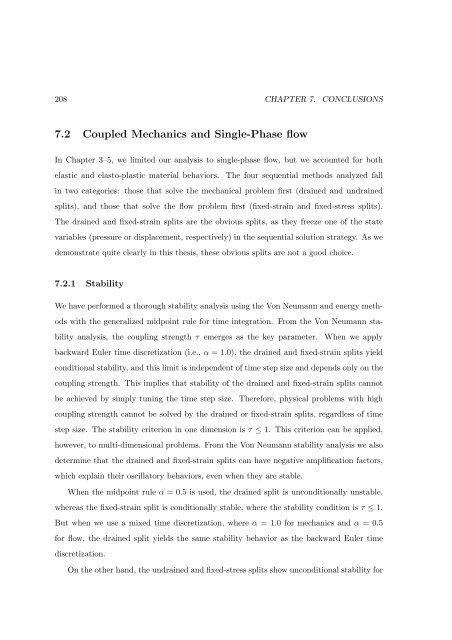Sequential Methods for Coupled Geomechanics and Multiphase Flow
Sequential Methods for Coupled Geomechanics and Multiphase Flow
Sequential Methods for Coupled Geomechanics and Multiphase Flow
You also want an ePaper? Increase the reach of your titles
YUMPU automatically turns print PDFs into web optimized ePapers that Google loves.
208 CHAPTER 7. CONCLUSIONS<br />
7.2 <strong>Coupled</strong> Mechanics <strong>and</strong> Single-Phase flow<br />
In Chapter 3–5, we limited our analysis to single-phase flow, but we accounted <strong>for</strong> both<br />
elastic <strong>and</strong> elasto-plastic material behaviors. The four sequential methods analyzed fall<br />
in two categories: those that solve the mechanical problem first (drained <strong>and</strong> undrained<br />
splits), <strong>and</strong> those that solve the flow problem first (fixed-strain <strong>and</strong> fixed-stress splits).<br />
The drained <strong>and</strong> fixed-strain splits are the obvious splits, as they freeze one of the state<br />
variables (pressure or displacement, respectively) in the sequential solution strategy. As we<br />
demonstrate quite clearly in this thesis, these obvious splits are not a good choice.<br />
7.2.1 Stability<br />
We have per<strong>for</strong>med a thorough stability analysis using the Von Neumann <strong>and</strong> energy meth-<br />
ods with the generalized midpoint rule <strong>for</strong> time integration. From the Von Neumann sta-<br />
bility analysis, the coupling strength τ emerges as the key parameter. When we apply<br />
backward Euler time discretization (i.e., α = 1.0), the drained <strong>and</strong> fixed-strain splits yield<br />
conditional stability, <strong>and</strong> this limit is independent of time step size <strong>and</strong> depends only on the<br />
coupling strength. This implies that stability of the drained <strong>and</strong> fixed-strain splits cannot<br />
be achieved by simply tuning the time step size. There<strong>for</strong>e, physical problems with high<br />
coupling strength cannot be solved by the drained or fixed-strain splits, regardless of time<br />
step size. The stability criterion in one dimension is τ ≤ 1. This criterion can be applied,<br />
however, to multi-dimensional problems. From the Von Neumann stability analysis we also<br />
determine that the drained <strong>and</strong> fixed-strain splits can have negative amplification factors,<br />
which explain their oscillatory behaviors, even when they are stable.<br />
When the midpoint rule α = 0.5 is used, the drained split is unconditionally unstable,<br />
whereas the fixed-strain split is conditionally stable, where the stability condition is τ ≤ 1.<br />
But when we use a mixed time discretization, where α = 1.0 <strong>for</strong> mechanics <strong>and</strong> α = 0.5<br />
<strong>for</strong> flow, the drained split yields the same stability behavior as the backward Euler time<br />
discretization.<br />
On the other h<strong>and</strong>, the undrained <strong>and</strong> fixed-stress splits show unconditional stability <strong>for</strong>
















